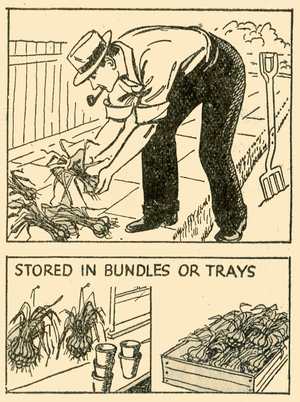Getting Runners to set
 Syringe the plants, and particularly the flowers, with water during hot weather to encourage the beans to form.
Syringe the plants, and particularly the flowers, with water during hot weather to encourage the beans to form.
And pinch out the growing tips of the main shoots when the plants have reached the tops of the sticks.
Harvesting SHALLOTS
 Shallots are ready for harvesting when the foliage has begun to wither. You then lift the little bunches of bulbs and leave them on the surface to dry off. But if the ground is heavy and moist, lay them out along a dry surface, such as a path, for a few days, for they must be well ripened and perfectly dry before storing.
Shallots are ready for harvesting when the foliage has begun to wither. You then lift the little bunches of bulbs and leave them on the surface to dry off. But if the ground is heavy and moist, lay them out along a dry surface, such as a path, for a few days, for they must be well ripened and perfectly dry before storing.
Or if you’ have got a strip of wire netting, you could dry them on this, raising it slightly from the ground to let a current of air pass beneath them. Then tie them into bundles or lay them in trays or boxes, and store in a dry, frostproof, airy shed. Look them over from time to time and throw out any decaying bulbs.
Thoroughly dried and stored in a cool place, shallots will store for as long as 18 months. As long as they’re not diseased, this year’s shallots can be planted out to provide next year’s crop.
Try a row of SPINACH BEET
If you have not sown a row of spinach beet or seakale beet earlier, try a row now. Either is a valuable vegetable and often survives the winter better than any other green crop. Sow the seeds in drills about 1 in. deep and allow 8 in. between plants. Always use spinach beet when the leaves are young and tender.
Sow those TURNIPS
If you are following the Ministry’s cropping plan, now is the time to sow turnips for storing on ground cleared of early potatoes, which should be in good condition for roots, as it will have been well worked during the past month or two. The rows should be 1 ft. apart and the seed sown about 1 in. deep.
- Keep Working, Control Caterpillars
- Cabbage Root Fly, Watering Advice
- Planting out Leeks & Feeding Onions
- Runner Beans, Harvesting Shallots, Spinach Beet & Turnips
- Cabbage, Compost, Carrots & Successional Sowing
- Green Crops for Winter, Brassicas
- Seed Saving – What You Can Save
- What & How of Seed Saving


